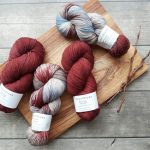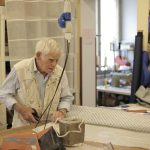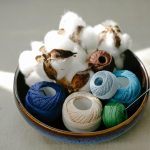If you’re looking to add some extra flair to your sewing projects, you may want to consider using a cord foot for your sewing machine.
A cord foot is a specialty presser foot that allows you to add decorative cords, piping, and other trims to your sewing projects.
There are several types of cord feet available, each with their own unique features and uses. Some cord feet are designed specifically for working with thicker cords or trims, while others are better suited for thinner ones.
By learning about the different types of cord feet and how to select the right one for your project, you can take your sewing skills to the next level and create beautiful, customized projects that are sure to impress.
Table of Contents
What is a Cord Foot?
A cord foot’s purpose is to make sewing cords and piping easier, so you don’t have to struggle with it! This foot is designed with a small tunnel on the underside, which allows the cord to easily pass through while you sew. It’s perfect for adding decorative touches to your projects or for functional purposes like creating drawstring bags or adding piping to a garment.
Using a cord foot is easy. First, you’ll need to select the right size cord for your project and thread it through the tunnel on the underside of the foot. Then, attach the foot to your sewing machine and adjust the needle position as needed. As you sew, the cord will be guided through the tunnel, creating a neat and even stitch.
One of the great things about a cord foot is that it can save you time and effort. Instead of having to sew the cord in place by hand, you can use the cord foot to quickly and easily sew it in place. This can be especially helpful when you’re working on a project with multiple cords or when you’re working with thicker materials that can be difficult to sew by hand.
So, if you’re looking to add some decorative touches to your sewing projects or just want to make your sewing life a little easier, consider investing in a cord foot for your sewing machine.
Types of Cord Feet
One may differentiate between various styles of these attachments for their device. There are different types of cord feet available in the market. Each type of cord foot is designed to cater to specific sewing needs. Let’s take a look at the different types of cord feet available.
| Type of Cord Foot | Description | Best Used For |
|---|---|---|
| Braiding Cord Foot | Has a small hole to guide a cord through it | Adding a decorative touch to fabric edges |
| Pearl Cord Foot | Has a groove on the bottom to hold pearls or beads | Creating strings of beads or pearls on fabric |
| Cording Foot | Has grooves on the bottom to guide cords or threads | Adding piping or cording to fabric |
The Braiding Cord Foot is perfect for those who want to add a decorative touch to their fabric edges. It has a small hole that guides a cord through it, allowing you to create beautiful braids. The Pearl Cord Foot, on the other hand, is designed to hold pearls or beads in place as you sew. It has a groove on the bottom that helps keep the pearls or beads in place, making it easier to create strings of beads or pearls on fabric.
If you want to add piping or cording to your fabric, then the Cording Foot is the perfect choice for you. It has grooves on the bottom that guide cords or threads, making it easier to sew piping or cording onto fabric. Whether you want to add a decorative touch to your fabric, create strings of beads, or add piping or cording, there is a cord foot that can help you achieve your desired results.
Selecting the Right Cord Foot for Your Project
Choosing the perfect cord foot for your project can be a game-changer, enhancing the overall look of your creation. Here are some things to consider when selecting the right cord foot for your sewing machine:
-
The type of cord you’ll be using: Different cords come in different thicknesses, so it’s essential to choose a cord foot that can accommodate the size of cord you’ll be using.
-
The fabric you’ll be using: Some fabrics are more delicate than others, and a cord foot that’s too heavy or too rough can damage the fabric. Be sure to choose a cord foot that’s appropriate for the fabric you’ll be using.
-
The type of stitch you’ll be using: Some cord feet are better suited for certain types of stitches than others. For example, a cord foot with a groove down the middle is ideal for creating a decorative corded stitch. Be sure to choose a cord foot that’s compatible with the stitch you’ll be using.
By taking these factors into account, you can choose the perfect cord foot for your project and achieve a professional-looking finish.
Don’t be afraid to experiment with different cord feet to see which one works best for you and your sewing machine. Happy sewing!
How to Attach the Cord Foot to Your Sewing Machine
Attaching the cord foot to your machine is easy and quick, and all you need to do is follow these simple steps.
First, make sure your machine is turned off and the needle’s in the up position.
Then, locate the presser foot release lever and lift it up to remove the current presser foot.
Next, take the cord foot and align its shank with the presser foot holder. Lower the foot onto the holder and make sure it snaps into place.
Once the cord foot is secured, lower the presser foot lever, and you’re ready to start sewing.
It’s important to note that the cord foot is designed to be used with a specific type of cord. Before attaching the cord foot, ensure that you have the appropriate cord for your project.
With a little practice, attaching the cord foot will become second nature, allowing you to easily add decorative cord accents to your sewing projects.
Tips for Using the Cord Foot
Get creative with your projects by using the cord foot to add unique, decorative touches that’ll impress anyone who sees them. Here are some tips to help you get the most out of your cord foot:
-
Experiment with different types of cords and threads to achieve different effects. Thicker cords’ll create a more prominent texture, while thinner cords’ll create a more delicate effect.
-
Practice on scraps of fabric before starting on your main project. This’ll allow you to get a feel for the cord foot and adjust your tension settings as needed.
-
Use contrasting colors to make your cord stand out. This’s a great way to add a pop of color to an otherwise plain project.
-
Don’t be afraid to mix and match different types of cords and threads. The possibilities’re endless and can lead to some truly unique and beautiful results.
Remember, the cord foot’s a tool that can help take your sewing projects to the next level. With a little bit of practice and creativity, you’ll be able to create beautiful, textured projects that’ll impress everyone who sees them.
Creating Decorative Stitches with the Cord Foot
Enhance the aesthetic appeal of your projects by adding unique and intricate decorative stitches with the help of the cord foot attachment. The cord foot is an incredibly versatile tool that can be used to create a multitude of decorative stitches. With the cord foot, you can add depth and dimension to your sewing projects in a way that’s not possible with regular stitches.
One way to create decorative stitches using the cord foot is to use it in conjunction with a zigzag stitch. Simply insert a piece of cord or yarn into the groove of the cord foot, and then sew a zigzag stitch over it. This will create a raised stitch that can be used to embellish clothing, bags, and other projects. You can experiment with different types of cords and yarns to create unique textures and patterns.
Another way to use the cord foot is to create a braided stitch. To do this, simply insert two or more cords into the groove of the cord foot, and then sew a straight stitch over them. As you sew, the cords will be braided together, creating a beautiful and intricate design. This technique can be used to embellish pillows, table runners, and other home decor items.
Overall, the cord foot is a versatile and essential tool for any sewing enthusiast looking to add a little extra flair to their projects.
- A Guide to Neutral Ikat Fabrics for a Subtle, Sophisticated Look - June 27, 2025
- Green and Blue Ikat: Bringing a Touch of Nature Indoors - June 27, 2025
- The Allure of Pink and Orange Ikat Fabric: A Style Guide - June 27, 2025






